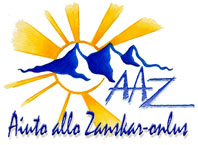
Tibetan Children's Villages
TCV
Progetto Sumdho
Sumdho vuol dire "confluenza" ed in queste pagine confluiscono alcune iniziative per sostenere l'attività di questa piccola scuola per rifugiati tibetani

Aiuto allo Zanskar
onlus

Tibetan Children's Villages |
Progetto SumdhoSumdho vuol dire "confluenza" ed in queste pagine confluiscono alcune iniziative per sostenere l'attività di questa piccola scuola per rifugiati tibetani |

Aiuto allo Zanskar |
The arrival in Leh took away my breath, because of the lunar landscape, surrounding the valley and its height to which you are never prepared. During the landing, snowy summits of the glaciers, piercing the clouds, were dimly seen. Once landed, the sight was special. The Karakorum chain raises up majestically to the sky, with its numerous whitened peaks, in an almost desert environment except a narrow tongue, particularly fertile, which runs by the side of the Indo River.
Ladakh presents strong contrasts, the harshness of the landscape, the rarefaction of the air, the prohibitive winter temperatures, the character of its inhabitants, the respect they have for the environment in which they live, the hospitality offered to tourists and to the Tibetan refugees, the pacific coexistence, the Buddhist dictates.
Ladakh is a land, in appearance extremely poor but infinitely richer than other Indian Regions, where the expression of universal values is shared by a mixture of races and men, speaking different languages, identifying themselves in a unique, true world ideal: Fraternity.
With this attitude I pushed on visiting Choglamsar, passing from a monastery to another, the village of Tibetan children on the edge of Leh.
Tibetan installations of Ladakh date back to the 70’s. The camps for nomad refugees were created aside the Indo/Tibetan borders. The village I visited was built in 1975, thanks to a small amount of money, about 10.000 Indian rupees, kindly offered by the Dalai Lama and thanks to the land given by the Indian government. To day , beyond the SOS village, primary and secondary schools are providing assistance to the Tibetan people.
Visiting the houses and the classes hosting the children, the first reaction was a pang in my heart. They stared at me with a broken heart expression, with a very sad and questioning look, as if my Western presence might help them in finding again their parental smells and colours, probably lost forever.
The organisation of the 700 children hosted in the Choglamsar Centre is extremely functional. The alarm clock rings every day at six o’clock in the morning , in the small houses sheltering 20 children. Then come more or less brief ablutions, followed by breakfast and by a daily assembly until 8,45 a.m. Regular courses are then held, until one p.m.. At that time children go back home for an hour and take their lunch inside, where a tiny kitchen is installed. In the afternoon cultural and sport activities take place. At 6 p.m. dinner is served, and at 9 p.m lights are switched off . In this Region the winter climate, from October to May is particular severe, with temperatures reaching – 30C°. In the village most of the constructions do not use heating. They were properly built to exploit solar energy. For what concerns the courses they are officially certified by the Indian government that at the end of each scholar cycle issues regular degrees. The “Montessori” method followed in several SOS villages for Tibetan children seemed to me extremely efficient. However the adoptive mother, who attends 20 children has to take care of their meals, their hygiene, their life organisation is perhaps weighed down by work . In fact eight is the ideal number of children to attend to, but considering the Centre efforts, this factor probably has not the right priority due to the enormous problem that have to be faced. The young hosts wear a grey uniform with a blue jumper, manufactured by the operators and the young boys who want to learn a job after the secondary school. All children, wore leather shoes, on that special day of June 2001. Every small house hosting the children has a front orchard to satisfy the needs of its community. The excess production is sold to the central group which absorbs the fresh products in exchange of a small amount of money. The drying process needs a very intensive activity, engaging, in summer time food processing operators with the objective of being equipped to face. the long winter in Ladakh, trying to reduce waste and consumption. The Centre budget amounts to about 36.000 $ a month.
The Centre offers training, seminars and up to date meetings for teachers, doctors, nurses and has a very important role inside the organisation. Choglamsar village, with its 100 acres offers a dentist service too, open to the Tibetan people from the surroundings . With special prices they may utilise a quality service, some emergency beds, a dentist laboratory equipped with all the basic instruments, and a library too.
My heart is left behind in Choglamsar, a reality you can hardly imagine. If you are visiting those areas, do not forget to visit it.